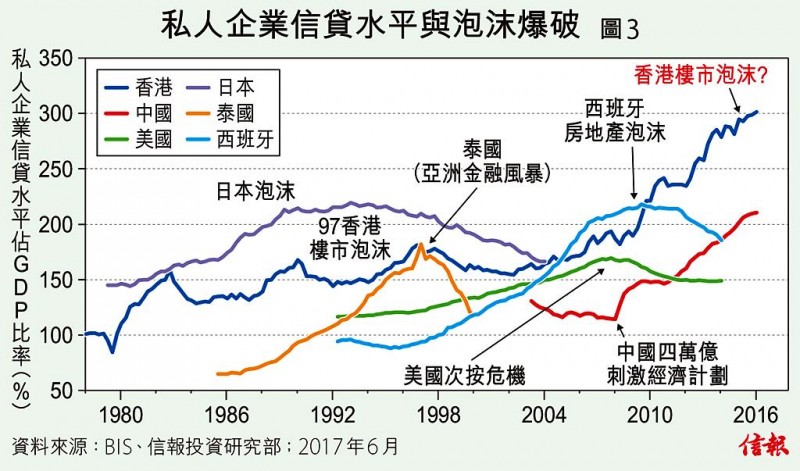The Centa-City Leading Index, a gauge of secondary housing prices in Hong Kong, eased last week. That marked the first decline after a 19-week rally but does that mean a meaningful correction is around the corner?
Hong Kong’s home market has gone through two bull cycles since 1984. The second bull cycle started in July 2003 due to a combination of factors, including a sharp downturn in the previous year, economic recovery as well as the influx of money due to global monetary easing.
Hong Kong’s monetary base has soared more than four times since the Federal Reserve started its QE (quantitative easing) program. By contrast, the monetary base in the US expanded by 3.8 times in the same period.
If the city’s housing price boom is largely due to fund inflows and abundant liquidity, it is unlikely to reverse unless the situation changes drastically.
Now that the Fed has hiked interest rates four times and would start to reduce its balance sheet later this year, is that a prelude to a much tighter monetary environment? Perhaps not.
So far, Hong Kong’s monetary base remains above HK$1.6 trillion. Therefore, the Fed’s rate hikes have had little impact on the massive capital parked in Hong kong.
Meanwhile, the Fed’s pace of reducing its balance sheet is going to be quite gradual.
According to the plan, the initial cap for the reduction of the Fed’s Treasuries holdings would be set at US$6 billion per month, increasing by US$6 billion increments every three months over a 12-month period until it reached US$30 billion per month.
For agency debt and mortgage-backed securities, the cap will be US$4 billion per month initially, rising by US$4 billion at quarterly intervals over a year until it reached US$20 billion per month.
Such slow and prudent approach is unlikely to bring any immediate shock or trigger any substantial capital outflow in Hong Kong.
Also, normalization of the Fed’s balance sheet would support the US dollar and thus may put pressure on the Chinese yuan.
We have seen notable fund inflows from China after the one-off exchange rate reform in August 2015. That means if the yuan weakens, more mainland capital may flow into Hong Kong, offsetting the impact of the Fed’s balance sheet reduction exercise.
A major pullback of home prices does not look likely. Small adjustments, however, could be possible, given the very high private company borrowing ratio and the significant amount of purchasing power already absorbed by the market as reflected in the brisk home sales data over the past 12 months.
Translation by Alan Lee
樓價幾時回? 「縮表」促見頂?
呂梓毅
信報首席經濟及策略師
雖然上周五(23日)公布的中原城市領先指數(樓價指數)按周回落,惟這是今年1月23日樓價連升19周及屢破歷史新高後才首度出現;樓價升勢其實異常強勁。事到如今,相信不少人心中都有一個很大的疑問,就是樓價幾時才調整?甚至樓價幾時才會見頂?我們這次試從樓市大氣候和小氣候兩角度,探討這課題。
要探討樓市何時見頂,先要了解是什麼因素觸發目前的樓市大升浪。
正如月初本欄分析,自1984年起,本港樓市其實可劃分為兩個大型上升周期,第二個大升周期始於2003年7月至今(見2017年6月8日本欄)。第二個重大上升周期中,迄今亦可以界分為兩個階段(小型周期),分別是2003年7月至2008年12月,以及2008年12月至今。
不難發現,第一個階段的升浪,相信是樓價於2003年已跌至異常低殘水平,加上隨後經濟見底復甦配合帶動樓市上升;至於第二個階段的升浪則源自金融海嘯後,以美國聯儲局為首的主要央行推行極度寬鬆貨幣政策,令海量資金湧入香港,造就樓價再上層樓。
大氣候水源未竭
事實上,自2008年底聯儲局開始QE托市,香港貨幣基礎(monetary base)大致與美國同步攀升,從低位計 已激增1.3萬億元,或累計上升逾4倍,增幅甚至較美國同期約3.8倍更多【圖1】。
已激增1.3萬億元,或累計上升逾4倍,增幅甚至較美國同期約3.8倍更多【圖1】。
換言之,樓市目前的上升周期會否逆轉或見頂,其中一個重要因素(或筆者所言的大氣候),便是已流入香港的資金顯著流走。那麼,隨着聯儲局已進行4度加息,甚至今年較後時間開始「縮表」(縮減資產負債表規模)行動,會否令資金流出香港呢?
從最新香港貨幣基礎數字來看,迄今仍維持在1.6萬億元之上高位徘徊,可見聯儲局過去近年半的加息行動,似乎尚未能導致資金明顯流出香港【圖1】。
至於「縮表」,預計初期同樣未必會觸發太多香港資金流走,原因有三:
一、「縮表」步伐緩慢
在本月中的議息聲明中,聯儲局首度詳細交代「縮表」的安排。按照計劃,「縮表」啟動後每月將分別減持到期國債及按揭證券再投資額60億和40億美元;「縮表」規模每3個月擴大一次(各增加60億和40億美元),直至達到每月縮減300億美元國債和200億美元按揭證券。這足見聯儲局「縮表」步伐,尤其初期、首年仍是十分審慎和緩慢。故此,美國「縮表」行動對市場流動性造成收縮的影響,不會立竿見影,更遑論導致太多資金流出香港。
二、「縮表」或使人民幣再現貶值壓力
聯儲局「縮表」行動某程度為市場帶出減少「放水」的訊息,預料美元有走強空間(尤其歐日央行尚未進行類似收水行動),令人民幣貶值壓力再次浮現。值得注意的是,金融海嘯後香港貨幣基礎增幅甚至較美國為快,某程度得力於人民幣貶值壓力上升,帶動資金從內地湧入香港。君不見2015年「8.11」滙改後,香港的貨幣基礎進一步攀升嗎【圖1】?換句話說,縱使聯儲局「縮表」行動令香港資金流走,但由於在過程中,人民幣或呈現貶值,吸引資金從內地流入本港,抵消部分資金流出香港的壓力。
三、「縮表」暫難令市場息口顯著抽升
從3個月國庫券息率與貨幣基礎佔GDP比率集散圖可見,我們目前正處於極為偏右的位置【圖2】。即使聯儲局 開始「縮表」令貨幣基礎收縮,對債息(以至市場息率)造成上升的壓力,暫時來說仍然十分溫和,預料對資金流出香港的影響亦十分有限。
開始「縮表」令貨幣基礎收縮,對債息(以至市場息率)造成上升的壓力,暫時來說仍然十分溫和,預料對資金流出香港的影響亦十分有限。
由此可見,雖然聯儲局自2015年起已4度加息,甚至於今年較後時間開展「縮表」行動,惟僅從收水的角度看,預料對資金流出香港的壓力暫時依然十分有限。在這大氣候未出現逆轉前,香港樓價似乎仍未能擺脫大漲小回的狀態。
當然,聯儲局「收水」未必會「直接」觸動資金流出香港,但有關行動會否引發意想不到的市場震盪(因為即使聯儲局也無法保證有關退市行動有序進行),如加速市場人士拋售美國國債,令長達30多年的美債牛市完結,又或是股市顯著下挫,「間接地」觸動香港資金流走,均可能是其他重要的外在因素,令樓市周期出現逆轉(見2017年3月30日本欄)。
至於時間方面,筆者沒有水晶球,當然無法準確告知樓市轉勢的時間,這等同問金融危機幾時再出現〔這點讀者或可參考索耐特(Dr. Sornette)的模型〕;但筆者相信為期不會太遠,且在未來一兩年內(即股市接近完成最後升浪前)出現的機會頗高。
小氣候調整將至
 原因?自2008年金融海嘯後,香港私人企業信貸水平佔GDP比率再次急速攀升。截至去年底,該比率已突破300%大關,足見香港信貸於期內膨脹速度驚人。現時香港該比率已遠遠高於歷年不同國家信貸泡沫爆煲或金融危機出現時的水平,亦大幅拋離香港於1997年樓市泡沫爆煲時的位置【圖3】。歷史上從未有一個國家或地區,信貸以如此高速膨脹,而最終沒有觸發金融危機!你會相信今次不同嗎(This time is different)?
原因?自2008年金融海嘯後,香港私人企業信貸水平佔GDP比率再次急速攀升。截至去年底,該比率已突破300%大關,足見香港信貸於期內膨脹速度驚人。現時香港該比率已遠遠高於歷年不同國家信貸泡沫爆煲或金融危機出現時的水平,亦大幅拋離香港於1997年樓市泡沫爆煲時的位置【圖3】。歷史上從未有一個國家或地區,信貸以如此高速膨脹,而最終沒有觸發金融危機!你會相信今次不同嗎(This time is different)?
最後,從樓市的小氣候角度看,近月來一手樓銷售情況十分熾熱,即已在市場消耗龐大的購買力。個別有關數據亦開始逼近筆者所設計樓市模型的門檻水平,如12個月累計一手樓買賣宗數按年變化已攀升至約50%【圖4】。換言之,從一手樓的角度看, 香港樓市於今年第三季較後時間或第四季,有機會出現小周期調整,情況猶如2015年9月至2016年第二季般。當然,若然樓市在小周期調整完成後,外圍大氣候依然沒有出現逆轉情況,樓市調整過後,仍有再度回升的機會和空間。
香港樓市於今年第三季較後時間或第四季,有機會出現小周期調整,情況猶如2015年9月至2016年第二季般。當然,若然樓市在小周期調整完成後,外圍大氣候依然沒有出現逆轉情況,樓市調整過後,仍有再度回升的機會和空間。


